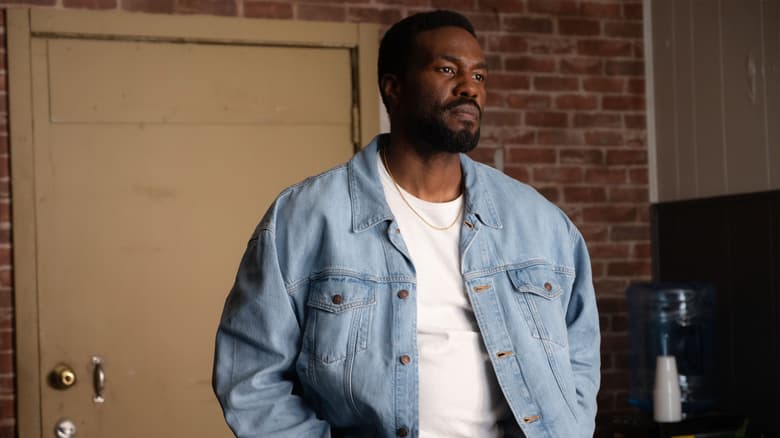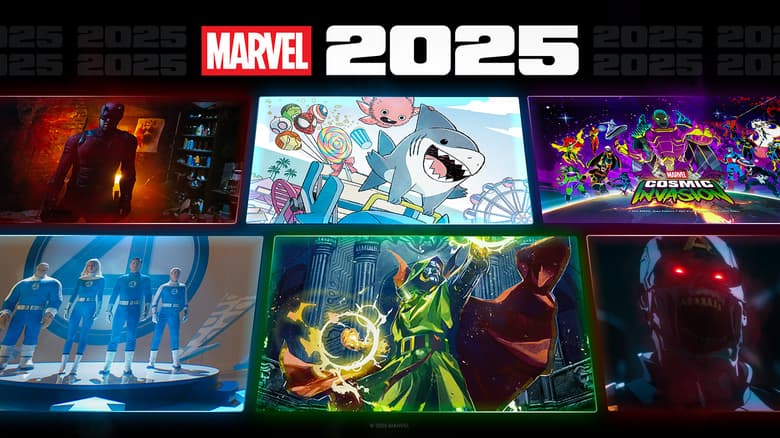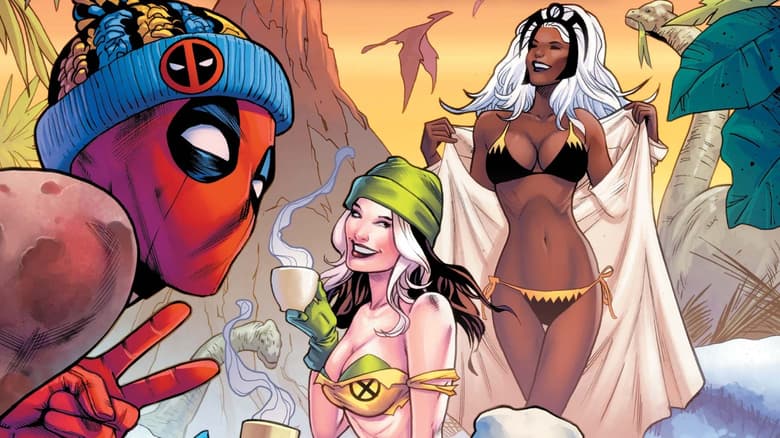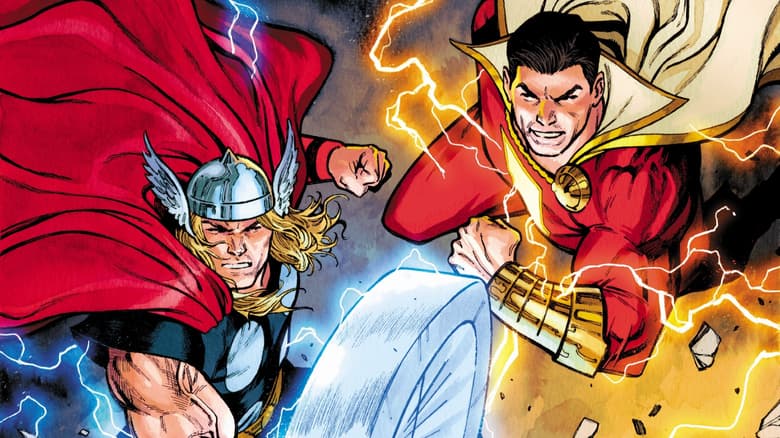R.L. Stine Makes His Man-Thing
The acclaimed writer brings a blend of humor and horror to one of Marvel’s most unique heroes!
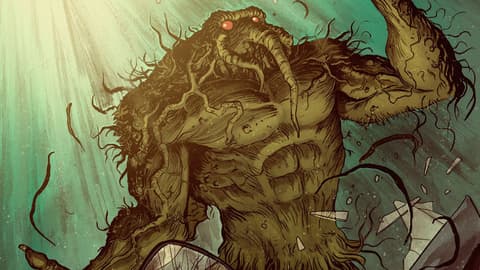
For years, he has ruled bookshelves everywhere. Then he expanded his empire to small screens. Most recently, he conquered the box office. Now, R.L. Stine has come to comics, back to where his love of storytelling first began.
A fan of comics from his youth, the king of the Goosebumps empire has finally teamed with Marvel to deliver scares to his fans in the pages of an all-new MAN-THING series. We talked to him about his love of muck monsters and pitch black humor, plus why he had to give up on the idea of making a life as a comic book artist and more.
Marvel.com: Just straight away, given Man-Thing’s power set and his tagline—“Whoever know fear burns at the Man-Thing’s touch”—the idea of hiring a horror writer like yourself is pretty straightforward. From your perspective, from a creative mindset, however, what is attractive about taking on a Man-Thing story?
R.L. Stine: You know I honestly couldn’t tell you why. I just have always had a thing for swamp creatures. I even did a Goosebumps just last year called “Here Comes the Shaggedy” about a really hideous swamp monster. I just think it is horror character #1; it’s your basic nightmare, of this thing rises up from the muck, this hideous thing. It’s just always appealed to me.
So when I saw Man-Thing was available to do, that they weren’t using it, I said, well, let me try it. Let me see what I can do differently with it.
Marvel.com: You have said that you’ve enjoyed comics, that you grew up with them, and you’ve touched on comics in your books, telling stories about comics and comic book characters like “The Masked Mutant”—
R.L. Stine: Yeah, that’s right. That’s one of the best ones, I think, actually. One of the best Goosebumps books. I like that one.
Marvel.com: Right, exactly. So having spent so many years reading comics and then writing about them at times, how did the experience of actually tackling comic book writing match up with years of being a fan and of imagining comic book characters?
R.L. Stine: Back then I wanted to draw them. That’s what I wanted to be: the artist. But I had no talent, had no drawing talent of any kind. If I draw now, it looks like a third grader.
I realized at a very young age—when I started to bring in my own little comic books in fourth grade and everyone would say, “You suck,” and “Those are terrible,”—I realized that I would have to write.
Marvel.com: On the subject of art, as a writer who is used to writing prose, how has the transition been to having your words appear right with the art?
R.L. Stine: I’ve always tried to be very visual. Like in my Goosebumps books. They are very simple books and everything I’ve always tried to make it so kids can always visualize the location, the setting, what is going on—you spend a lot of time describing where the characters are.
In this it was a little different. In writing MAN-THING, I kind of left a lot of that up to the artist and mainly just concentrated on telling the story and on the dialogue. It was kind of like writing a script, like writing a TV script for something, where you don’t really have to concentrate that much on describing the backgrounds.
The process is a new thing, it’s very different. It’s very strange to see all this finished art—first you see the sketches, then you see the pencils, then the inks, then it’s colored, and still there [are] no words. No words anywhere. To me that’s really bizarre.
That came as quite a surprise that the [words] come on last.
Marvel.com: Have you had a chance to see any of the artwork from German Peralta, Daniel Johnson, or Christopher Mitten on the first couple of issues?
R.L. Stine: Oh, I’ve seen a lot of it!
I love it. I love the [Tyler Crook] covers. I think just German is fabulous. He’s great with violence. They all are. They’re all real violent and I love that. [German] especially is just great with that.
Marvel.com: You said earlier you wanted to do something different with Man-Thing and right out of the gate you start that by giving him/it speech back. You’re letting him exist beyond that silent shambling creature that he’s more or less only been for years now…
R.L. Stine: Yeah, I needed to. Otherwise…Man-Thing is so…he’s so hideous. He’s just such an ugly character it is hard to take him seriously. So I thought I would add a lot of humor. That would be very hard if he couldn’t speak. So I have him getting his human abilities back. They’re coming back. And then, he’s struggling, he’s striving; he wants to be human again, of course.
He’s very sarcastic—sort of in that Marvel mode. That kind of smart ass sarcastic dialogue. I think it helps the story a lot, not having him be that mute.
Marvel.com: And one of the first things he does when he gets that power of speech is to head out to Hollywood.
R.L. Stine: Yeah. He sees all the other Marvel characters and he thinks, “If Ant-Man can have a movie, well then why can’t I?”
Then they tell him, “Your tests came back. You tested really poorly. You scared all the kids. You’re too ugly to be in the movies.”
He asks if he can take the corporate jet back to the swamp then and they say, “Sorry, Ant-Man is using it.”
Marvel.com: Besides the lack of critical reception and excitement when he gets to Hollywood, another thing that is causing stress for him is once he leaves the swamp, bad things start to happen there.
R.L. Stine: Things are all out of order. Something is very wrong when he gets back. The animals aren’t acting right, nothing is right. It’s just…chaos.
Marvel.com: What is the emotion then to come back to this almost prison and have to redouble his efforts to fix it, to save it, tying him even more tightly to it?
R.L. Stine: He’s horrified. He’s very disappointed he didn’t make it in the movies and then he’s pulled back.
But he doesn’t really have time to think about it. This woman he knew before, when he was a scientist, is kidnapped by snakes and everything is so wrong he knows he has to fix it. He has to find out why everything is going so berserk.
So he doesn’t really have time to get into his thoughts. He is still thinking, “I was so close to back to human,” that kind of thing, but he can’t stop.
And then, on top of that, he starts entering other realities.
Marvel.com: While this is not the first time you’ve adapted other people’s works or characters, you’ve built your career and reputation predominantly on your own original creations. With that in mind, how is it for you to step into an existing character’s mythology, to play with a character that has been defined for years by a collection of other writers?
R.L. Stine: I’ve actually done a lot of things like this. I did a bunch of Indiana Jones books.
Marvel.com: Yes! The Find Your Fate series.
R.L. Stine: Yeah. Like a Choose Your Own Adventure. Right, right, Find Your Fate.
So I had to do Indiana Jones and get into that world. I had to do a couple that were James Bond.
Back in the early days of my career I did a bunch of movie novelizations which is getting into another world. I did the novelization for Mel Brooks’ “Spaceballs.” And I did the novelization of a Pee Wee Herman movie [“Big Top Pee Wee”].
But this was kind of interesting. I read the Steve Gerber [MAN-THING stories]. Just to find out what this was all about. I read them and thought “Ok, that’s what he did. What am I going to do that’s different?” I guess the humor element is what I’ve added.
Marvel.com: I’ve heard that part of the reason for the comedy element is drawing on the EC horror books with the black humor and the darkly ironic twist endings that you really responded to…
R.L. Stine: That’s right. The secret is—and it is really not much of a secret—is that I was always only interested in being funny. I never planned to be scary. I never planned to be a horror writer. It was all an accident. I always wanted to be funny.
I wrote about a hundred joke books for kids and I wrote a humor magazine called “Bananas” for kids for 10 years. I always thought I’d just be funny.
Then an editor said, “I need a horror novel.” I said, “Ok, I’ll do it.” She gave the title. “Go home and write a book called ‘Blind Date.’” She gave me the title and everything.
So I bought a bunch of teen horror books to see what this sort of thing was all about, went home and wrote it. And it was a #1 best seller! So I thought, wait a minute, forget the funny stuff. So I’ve been scary ever since.
Marvel.com: When I was in my teens, I worked in a bookstore and I can remember repeatedly having to shelve “Blind Date” because it was one of those books that always sold and we’d always reorder. I can remember that cover distinctly.
R.L. Stine: I loved the 90’s! [Laughs] The 90’s were great.
Marvel.com: Given your affection for the black humor balanced against the violence, is it fair to say that MAN-THING will be defined by that tone?
R.L. Stine: Yes, yes it is. And there’s also some insult humor. [Man-Thing] gets insulted walking the streets of Burbank. People are just horrible to him. I mean, he looks like a garbage heap.
But I get serious too. There’s a lot of good violence, a lot of fighting, diving into all the worlds he has to save. Presenting Old Father who is the master of the swamp. It’s got a lot of comic book elements. This isn’t a satire.
Marvel.com: In addition to the main stories in MAN-THING, each issue has a short straight horror tale as a backup with art by the likes of Daniel Johnson and Christopher Mitten.
R.L. Stine: Well, I thought they should know it was me. So we did a four or five-page old fashioned horror comic [story] for each issue.
Marvel.com: Given that you loved that stuff as a kid, it must be a thrill to do that, even if it didn’t have the Marvel stamp on the cover.
R.L. Stine: Yeah, right. It’s fun!
Marvel.com: What would you tell the readers and life-long R.L. Stine fans considering adding this to their monthly pulls?
R.L. Stine: If they enjoy my other work, then I think they are really going to enjoy this because it is the same combination of horror and humor, just taken to an all new medium and paired with great illustrations. I think they’ll love this.
[Laughs] I think that might sound a little immodest of me.
Marvel.com: I think that’s ok. We have a pretty good history in comics of selling ourselves.
R.L. Stine: [Laughs] Alright then. There you go.
Look for R.L. Stine’s MAN-THING beginning in March of 2017!
The Daily Bugle
Can’t-miss news and updates from across the Marvel Universe!

